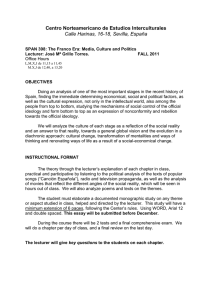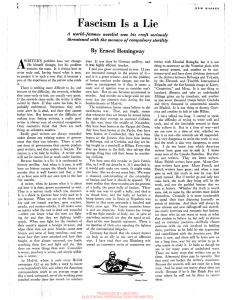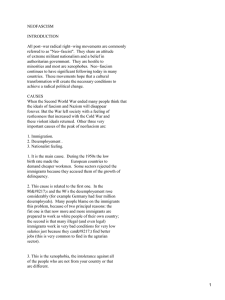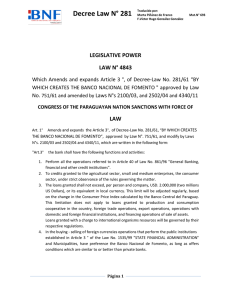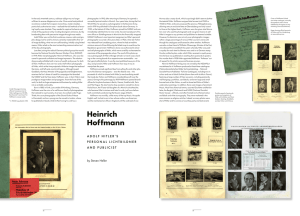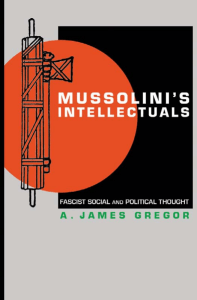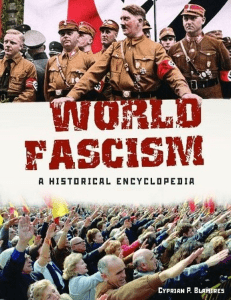Franco`s Spain in comparative perspective
Anuncio
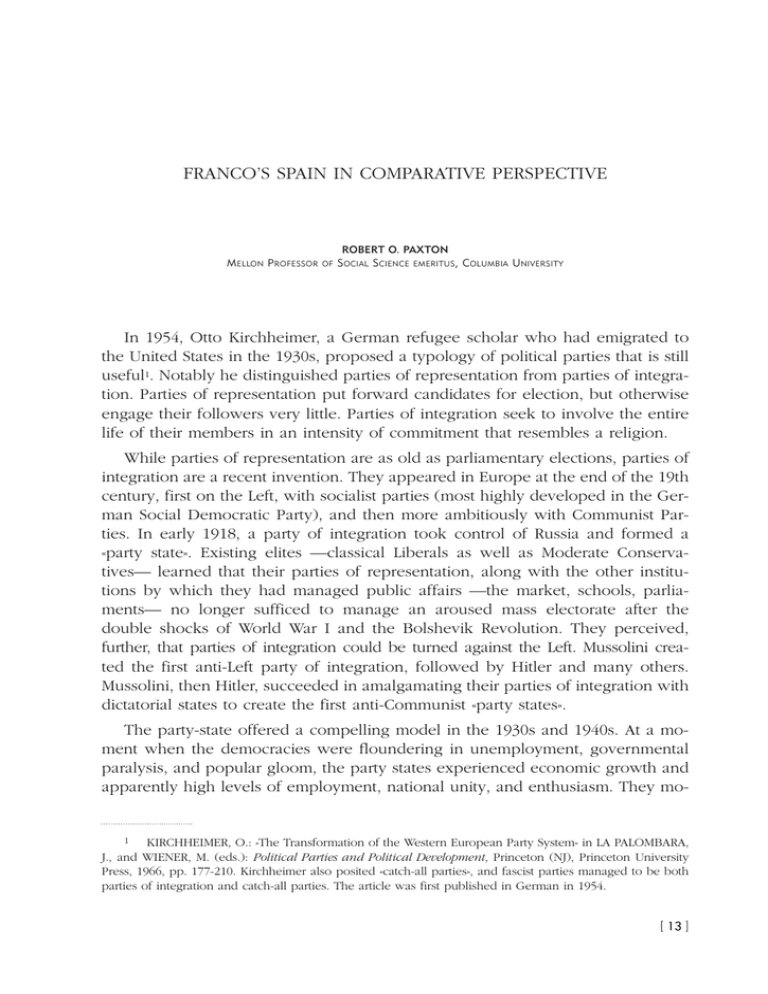
FRANCO’S SPAIN IN COMPARATIVE PERSPECTIVE MELLON PROFESSOR OF ROBERT O. PAXTON SOCIAL SCIENCE EMERITUS, COLUMBIA UNIVERSITY In 1954, Otto Kirchheimer, a German refugee scholar who had emigrated to the United States in the 1930s, proposed a typology of political parties that is still useful1. Notably he distinguished parties of representation from parties of integration. Parties of representation put forward candidates for election, but otherwise engage their followers very little. Parties of integration seek to involve the entire life of their members in an intensity of commitment that resembles a religion. While parties of representation are as old as parliamentary elections, parties of integration are a recent invention. They appeared in Europe at the end of the 19th century, first on the Left, with socialist parties (most highly developed in the German Social Democratic Party), and then more ambitiously with Communist Parties. In early 1918, a party of integration took control of Russia and formed a «party state». Existing elites —classical Liberals as well as Moderate Conservatives— learned that their parties of representation, along with the other institutions by which they had managed public affairs —the market, schools, parliaments— no longer sufficed to manage an aroused mass electorate after the double shocks of World War I and the Bolshevik Revolution. They perceived, further, that parties of integration could be turned against the Left. Mussolini created the first anti-Left party of integration, followed by Hitler and many others. Mussolini, then Hitler, succeeded in amalgamating their parties of integration with dictatorial states to create the first anti-Communist «party states». The party-state offered a compelling model in the 1930s and 1940s. At a moment when the democracies were floundering in unemployment, governmental paralysis, and popular gloom, the party states experienced economic growth and apparently high levels of employment, national unity, and enthusiasm. They mo- 1 KIRCHHEIMER, O.: «The Transformation of the Western European Party System» in LA PALOMBARA, J., and WIENER, M. (eds.): Political Parties and Political Development, Princeton (NJ), Princeton University Press, 1966, pp. 177-210. Kirchheimer also posited «catch-all parties», and fascist parties managed to be both parties of integration and catch-all parties. The article was first published in German in 1954. [ 13 ] ROBERT O. PAXTON bilized national wills and resources in a burst of energy unknown with earlier forms of the nation-state. During the high era of the Party-State (1926-1945), this seemingly successful new model had many emulators. Only in 1945, when Stalin’s party-state defeated Hitler’s party-state, did what Philippe Burrin has called the «champ magnétique» of fascism2 lose its attractive power. No two emulators were alike, however. Each one was unique because of the particularities of individual national settings and of individual leaders’ qualities. This is what makes their comparative study fruitful. This conference seeks to examine Franco’s Spain as a party-state. My particular purpose is to assess it in comparison with the classical fascist party states. How important was the Falange to the Franco State? Did the party succeed in fascisti-zing the Spanish State after 1939, or was it completely subordinate to Franco’s will, and limited to relatively unimportant, largely ceremonial functions? In my own work on fascism, I tried to replace static, essentialist definitions by an approach that accounted better for fascism’s alterations in time, and its dynamic character. I proposed that we envision fascism as a series of processes, evolving in a kind of life cycle through five stages3: (a) the formation of movements (b) the rooting of movements (c) taking power (d) exercising power (e) the longue durée: radicalization, or entropy This approach reveals that each stage in a fascist life cycle has its own dynamic. Fascist parties, in particular, function differently at each stage. At the formation and rooting stages, when they are trying to sweep all the discontented into one movement, fascist parties tend to be programmatically broad and economically radical. At the stage of coming to power, they focus their discourse and their energies more narrowly on their claims to being the only effective agent for national regeneration and the only effective barrier to a Communist take-over. In the exercise of power, they jostle for influence with the fascist leader’s conservative allies. Under the pressures of war, they become radical again. Further, fascist movements are not comprehensible in isolation. We need to pay particular attention to the role of alliances in their coming to power and in their exercise of it, and to the particularities of each national setting. These dif- 2 3 [ 14 ] BURRIN, P.: «La France dans le champ magnétique des fascismes», Le Débat, 32 (1984), pp. 52-72. PAXTON, R.O.: La Anatomía del Fascismo, Barcelona, Península, 2005. FRANCO’S SPAIN IN COMPARATIVE PERSPECTIVE ferences make comparison possible. Comparison finally helps distinguish what was essential from what was accidental in the fascist experience. I propose in this paper to examine the Falange and its role in Franco’s Spain in terms of these five stages. This approach comes naturally for the Spanish case, since Franco transformed his regime into something quite different after 1945, and again after 1959. Scholars are already accustomed to talking about «first» and «second» Francoisms. (1) The formation of movements: Like every other modern state, Spain generated its own more or less overtly fascist movements in the years following World War I. Indeed no modern state failed to have «first-stage» fascism in the 1920s and 1930s. Spain was, in fact, rather rich in fascist beginnings. The two most important, the Juntas de Ofensiva Nacional-Sindicalista of Ramiro Ledesma Ramos (1931), and the Falange Española of José Antonio Primo de Rivera (1933), fused in 1934 into the Falange Española de las JONS. In comparative perspective, firststage fascism was notable in Spain for three features. One was its Catholic fervor (only the Romanian Iron Guard and the Finnish Lapua, among movements generally considered fascist, were equally religious). Another was the upper-class origin and excellent education of the principal leader, José Antonio Primo de Rivera —only Sir Oswald Mosley of the British Union of Fascists matched him in these respects. Finally, early fascism remained weak in Spain, for Catholic conservativism occupied most of the available space and nationalism tended to refer to peripheral nationalisms. The FE de las JONS received only 0.7 percent of the vote in February 1936. Spanish fascism was also notable for the vigor of its criticism of market capitalism. (2) The rooting of movements. Fascism became an important political player in only a few national cases, so here comparison assumes more weight. The Spanish case is surprising. An outsider might think that circumstances were ripe in the Spanish Second Republic for the rapid development of a large and active fascist party. The Republic’s first election in 1931 had given power to a center-left coalition, which embarked on reforms of land tenure, military structure, and religious institutions that threatened the possessors of economic and social power. Insurrectionary strikes and land seizures spread out of control in 1931-33, and again in early 1936. Democratic institutions seemed unable to protect property and order. In the German and Italian cases, the Nazis and the Italian Fascists made themselves indispensable by becoming the defenders of important interests under crisis conditions and grew rapidly into movements so powerfully implanted that the political establishment was required either to fight them or to court them. In the Po Valley of northeastern Italy, landowners, frightened by militant workers and their unions, called upon Mussolini’s Blackshirted «squadristi» to rees[ 15 ] ROBERT O. PAXTON tablish their authority by direct action4. In Germany, the Nazis emerged as the main defender of small farmers in Schleswig-Holstein5, and gained attention as the most violent force opposing Communists in the streets of Berlin6 and other German cities and towns, and the most uncompromising advocates of national unity, revival, and expansion after the humiliating Treaty of Versailles7. Nothing similar happened in Spain. The threatened landowners of Andalusia did not call upon the Falange to protect them from their workers. They called upon the police and the army. And in Spain, the role of restorer of order and reverser of national decline fell to the Army. It may well be that the military rising of July 18, 1936 preempted the growth of an autonomous fascist party as the strongest force against the Left and perceived national decline. It was only after the Civil War began that the Falange grew rapidly into an important force in Spanish society through its creation of a Militia of Nationalist volunteers. The Falange’s late rooting had important effects. The Falange had little claim to a major role in the future governance in Spain because it had never been indispensable to the anti-Left camp at an early stage. It should be added that the obligatory merger of the FE with the Carlists in April 1937 to form the FET y de las JONS further reduced the Falange’s independent voice, even though the Falange remained the dominant force within that coalition. (3) Coming to power. The Nazis and Fascists had already become major actors on the national political scene well before their leaders attained power. The Fascist squadristi had become the de facto local government in the Po Valley and other parts of northeastern Italy by 1921 and 1922. The Nazis won 37% of the vote at their peak, in July 1932, only to slip a bit in the parliamentary election of November 1932. Both parties had become so powerful that the existing political elites were required to take them into account. In both cases, the conservative authorities, sensing that their power was slipping, invited the Fascist and Nazi leaders to share and reinforce it, by steps that were overtly legal even though the situation was highly abnormal. Facing the alternatives of coopting the fascist 4 CORNER, P.: Fascism in Ferrara 1915-1925, Oxford, Oxford University Press, 1966. HEBERLE, R.: Landesbevölkerung und Nationalsozialismus. Eine soziologische Untersuchung der politischen Willensbildung in Schleswig-Holstein, Stuttgart, Deutsche Verlags-Anstalt, 1963. A brief English version is HEBERLE, R.: From Democracy to Nazism: A Regional Case Study on Political Parties in Germany, New York, Grosset and Dunlap, 1970. This dissertation was completed just as the Nazis reached power in 1933, but Heberle went into exile in the United States. Schleswig Holstein was the only German state where the Nazis won an outright electoral majority in 1932. 6 ROSENHAFT, E.: Beating the Fascists? The German Communists and Political Violence, 1929-1933 Cambridge, Cambridge University Press, 1983. 7 ALLEN, W. S.: The Nazi Seizure of Power: The Experience of a Single German Town, 1922-1945, revised edition, New York, Franklin Watts, 1984. 5 [ 16 ] FRANCO’S SPAIN IN COMPARATIVE PERSPECTIVE movements or fighting them, they preferred to try to coopt them8. Fighting them seemed to them likely to aid the Left. Spain followed a profoundly different course. The Army took power by force of arms. It rose against the Republic and won a devastating civil war. It did so largely with its own resources, though military aid from Italy and Germany were indispensable at the beginning. The Falangist Militia aided Franco’s victory, but less so than the Carlist Requetés. Spanish fascism was in no way indispensable to Franco’s success, whereas the Nazi and Fascist parties had been indispensable to the success of Hitler and Mussolini. Franco won power almost alone. The Falange had limited leverage over him in 1939. The way was open for Franco to form a simple military dictatorship. Outright military dictatorships were not rare in interwar Europe, as the examples of Marshal Pilsudski in Poland, Marshal Antonescu in Romania, and General Metaxas in Greece demonstrate. As a general rule, traditional conservatives, like these military dictators, preferred to rule alone, without the troublesome intrusion of an unruly populist party looking for offices and spoils and disturbing public order. Sometimes the military dictators crushed troublesome fascist partners, as Antonescu repressed the Iron Guard bloodily in Romania in January 1941. In view of these comparisons, Franco’s decision to follow a different and singular path and make the Falange an integral part of his regime demands explanation. The explanation is not personal. Franco did not have friendly relations with José Antonio, and he imprisoned José Antonio’s successor, Manuel Hedilla. The reason was not ideological. Although Franco had a very favorable impression of the Nazi and Fascist regimes and copied some of their institutions, he was more pragmatic and opportunist than ideological. Several authors have suggested that Franco took lessons from the failure of General Miguel Primo de Rivera to establish popular roots capable of giving durability to his regime9. Franco apparently feared that his rule would be equally ephemeral if he did not have some kind of mass organization to generate support and mobilize opinion. He choose deliberately to attach a party of integration to his regime, and he continued to work with the Falange long after the era of party-states was over and when the party constituted something of a liability for him in his international relations. But he did so on his own terms, and not on the party’s terms. (4) Exercising power. This is the most interesting stage, so I will spend more time on it than on the others. When I was an adolescent, I was taught by Allied 8 LYTTELTON, A.: The Seizure of Power, New York, Charles Scribner’s Sons, 1973; TURNER, H. A.: Hitler’s Thirty Days to Power, Reading (MA), Addison-Wesley, 1996. 9 E. g. PAYNE, S.G.: Fascism in Spain, 1923-1977, Madison (WI), The University of Wisconsin Press, 1999, pp. 240, 478. [ 17 ] ROBERT O. PAXTON wartime propaganda that the fascist dictatorships —and especially the Nazi dictatorship— were monoliths driven by the singular will of the leader. This image has been overturned by historical scholarship. The predominant historical interpretation today among scholars is that Nazi Germany was «polycratic,» with multiple competing power centers with which the Führer had to contend10. In the German and Italian cases, there emerged a three-way contest for predominance among leader, party, and civil society. Both Hitler and Mussolini had difficult relations with their parties after coming to power at the invitation of conservative leaders who, also, needed to be placated. Hitler disciplined the unruly SA by murder, on the night of the Long Knives, 30 June 1934. Mussolini was pushed by some of his more ambitious Ras into establishing single party dictatorship in January 1926, in order to resolve the crisis opened by the murder by Fascist thugs of the socialist leader Matteotti the previous summer. By comparison, Franco seems remarkably unencumbered. It is even claimed that Franco ruled with «more absolute power than even Stalin or Hitler»11. The Falange, in short, played a smaller role in the functioning of the Francoist regime than the Nazi Party played in Hitler’s Germany or even the Fascist Party played in Mussolini’s Italy. It existed at the pleasure of the Caudillo, and whole areas of public life were closed to it by the particular power in the Francoist regime of the Church and the Army. Nevertheless the FET y de las JONS was not passive. It managed to assert itself and establish a role in Spanish political life within certain carefully delimited sectors: government administration, labor relations, university students, women, the press, and propaganda. This is now commonly referred to as the «fascistization» of Franco’s regime12. The term «fascistization» accords very well with my argument, for it embodies a sense of process. «Fascistization» includes, in fact, a number of different processes that I will distinguish below. Conventionally, «fascistization» is studied at the highest political level. The best current work on the German and Italian re- 10 BROSZAT, M.: The Hitler State: The Foundation and Development of the Internal Structure of the Third Reich, translated from the German by John W. Hiden, London and New York, Longman, 1981; MOMMSEN, H. in NIETHAMMER, L. and WEISBROD, B. (ed.): Der Nationalsozialismus und die deutsche Gesellschaft: Ausgewählte Aufsätze, Reinbeck bei Hamburg, Rohwohlt, 1991; FREI, N.: National Socialist Rule in Germany: the Führer State, 1933-1945, Oxford, Blackwell, 1993. 11 TUSELL, J.: Spain. From Dictatorship to Democracy, 1939 to the Present, Oxford, Basil Blackwell, 2007, p. 6. PRESTON, P.: Franco, New York, Basic Books, 1994, p. 175, writes, more judiciously, that except for independent power of the Church, «his [Franco’s] powers were comparable to those of Hitler and greater than those of Mussolini». 12 SAZ CAMPOS, I.: Fascismo y Franquismo, València, Universitat de València, 2004; SAZ CAMPOS, I.: «Fascism, Fascistization, and Developmentalism», Social History 29:3 (2004). [ 18 ] FRANCO’S SPAIN IN COMPARATIVE PERSPECTIVE gimes, in my view, studies these processes from below: in industry13, in labor relations14, in popular culture, in local and regional government. Some of the most interesting work on Spain that I discovered while working on this paper works in this way. We can break «fascistization» down into at least three particular processes: (a) The penetration of existing public services. The Falange played an important role in some administrative services. The striking thing about them how carefully limited these were. As already noted, the Falange played an important role in the press and propaganda, the syndicates, university student life, the organization of women, and local and regional government. But it was kept out of some particularly important functions in Spain, functions in which the German Nazi and Italian Fascist parties were influential. Education was controlled by the Church. The Falange ceased to have any military role after its militia was in dissolved in July 1944. The police and the judiciary were particularly crucial. Notoriously, Heinrich Himmler emerged in Germany by 1936 as, in effect, the national chief of police, a development which did a great deal to give the Nazi regime its ferocity. The Falange was kept out of police work, and indeed so was the Italian Fascist Party. The chief of police in Italy was a high civil servant, Arturo Bocchini. The magistracy was almost equally important, and after a brief period when the Falange played a major role in identifying and judging political suspects during the Civil War, army courts martial took over this task. In general the Spanish court system remained in the hands of professional magistrates. These did not challenge the dictator’s will, and despite the remarkable cruelty of the Francoist repression after 1939, nothing in Spain corresponded administratively to the Nazi Party’s Peoples’ Courts. Julián Sanz Hoya has studied the weight of Falange members in regional administration15. Numbers alone do not tell the whole story, of course, since a civil governor who was, simultaneously a general and a Falange member had a complex identity in which the party might not be uppermost. Just as we need to consider the Francoist regime in evolution, so the party/movement was also in evolution. Someone has said that a political party is like a bus: different people get on and off as it moves along. The Falange was filled by young militants in 13 WILSON, P. R.: The Clockwork Factory: Women and Work in Fascist Italy, Oxford, Oxford University Press, 1994; HAYES, P.: Industry and Ideology: I. G. Farben in the Nazi Era, Cambridge, Cambridge University Press, 1987). 14 CAPLAN, J. (ed.): Nazism, Fascism, and the Working Class; Essays by Tim Mason, Cambridge, Cambridge University Press, 1995; outstanding essays on the impact of Italian fascism upon Italian society are in BOCA, A. Del, LEGNANI, M. and ROSSI, M.G. (eds.): Il regime fascista: Storia e storiografia, Bari, Laterza, 1995. 15 SANZ HOYA, J.: «El partido fascista y la conformación del personal político local al servicio de las dictaduras de Mussolini y Franco,» Historia Social 71 (2011), pp. 107-123. See also the important earlier work of VIVER PI-SUNYER, C.: El personal politico de Franco (1936-1945), Barcelona, 1978. [ 19 ] ROBERT O. PAXTON 1936. After 1939 and especially later the membership changed in character. Many early militants were killed, and a number of survivors left the party in disillusion. As the regime became established, a new generation of members entered. Many of them were careerists and opportunists, but this was never totally the case and new generations of fervent militants continued to rise within the Falange. These sometimes caused trouble to the dictator, right to the end. (b) The creation of new agencies. Fascist parties sometimes extended their tentacles into areas of life that had not been organized before. Celebrated examples are the two leisure-time organizations, the Italian Dopolavoro and the German Kraft durch Freude. As far as I am aware the Franco regime showed little interest in letting the Falange extend its power into new areas of daily life. There was, however, one important exception: the party’s very successful Sección Femenina, with its array of social services. (c) A third «fascistization» process is the establishment of parallel structures party positions that exist side by side with traditional administrative positions to oversee and guide them, like the Nazi Gauleiter or the Fascist Federale. Franco’s advisor Carrero Blanco was keenly aware of the danger of this process, as demonstrated in his first memo to Franco August 25, 1941: Party «has constituted a duplicate state organization, maintaining a marked parallelism and a troubling duplication of function and dependency in certain positions...» [The party] has «grown without direction», has admitted «semi-Reds..., the amoral..., and... opportunists», and has «slipped through our fingers». He advised Franco to not abolish the party, but to discipline and subordinate it16. In Francoist Spain parallel structures were generally replaced by a system in which Regional governors and party chiefs were united in same person. If Falange survived, and retained some influence, the most important reason with Franco’s own choice: Franco found it useful as his «claque»17, and counterweight to the monarchists. He managed with considerable skill to use the movement without losing control of it. The party went along with this, because without the Caudillo it was nothing. Together they formed what Francisco Morente has called a «strategic alliance»18. Each partner needed the other. This «strategic alliance» satisfied opportu-nists and latecomers, but the continued existence of the party provided a setting where a few uncompromising «authentic falangists» could survive or reappear from time to time and agitate for completing the fascist revolution. 16 PAYNE: Fascism in Spain, pp. 365-366. Ibid., pp. 412, 421, 555 note 71. 18 MORENTE VALERO, F.: «Hijos de un dios menor. La Falange después de José Antonio», GALLEGO, F. and MORENTE VALERO, F.: Fascismo en España, Barcelona, El Viejo Topo, 2005, p. 224. 17 [ 20 ] FRANCO’S SPAIN IN COMPARATIVE PERSPECTIVE In the final analysis, Franco’s use of the party may most closely resemble the »trasformismo» practiced with success on the Italian Socialist Party before the First World War by Giovanni Giolitti (and without success on Mussolini’s Fascists after it). (5) Finally, we reach the fifth stage, in which, over the longue durée, fascist regimes are either radicalized or fall into entropy. For a regime that has invested so much in popular excitement, a stable moderation seems inconceivable. That Franco seems to have accomplished it may reflect the incomplete nature of his regime’s «fascistization,» but it surely reflects his abstention from war after 1939. The preeminent engine of radicalization for Germany and Italy was war. It was in the occupied eastern frontiers, in the no man’s land between Germany and the Soviet Union, that Nazi violence metastasized into the horrors of the Nazi occupation and the Final Solution. Mussolini’s Italy developed in Ethiopia in 1935-36 the racist policies it extended to the peninsula in 1938. In the last days of the Italian war, the Italian Social Republic at Salò returned to the radical roots of its Fascist beginnings. In this fifth stage, too, the Spanish case was quite different from the others. The Spanish case followed reverse order. Franco had his war at the beginning and then stayed out of war thereafter. Beginning with the departure of Serrano Suñer in 1942, processes of «defasticization» were set in motion, tentatively at first, and then more decisively after 1945. We know now that Spain’s avoidance of the second radicalization that would surely have accompanied participation in the Second World War had more to do with Hitler’s lack of interest than with Franco’s caution. As with Vichy France, one must study the German documents to understand how the relationship with Hitler worked. Hitler was briefly interested in Spanish cooperation on two occasions, once in October 1940, and again in November 1942, but on the first occasion he understood that he could not gratify Franco in Morocco without sending Vichy France into opposition. On the second occasion Hitler was too fully occupied with the Eastern Front to offer Franco sufficiently important military aid19. Then, with the defeat of the axis, the party-state model was discredited. In order to survive in an American-dominated Western world, Franco adapted his regime so successfully (profiting, in time, from the Cold War) that by the time of his death in 1975, the Francoist state had become the longest-lived dictatorship of the twentieth century, except for Salazar and Fidel Castro. But while Franco dismantled the outward signs of his «fascistized» regime, the Falange —now called simply Il Movimiento— did not disappear. «Defascistization» was never complete, just as «fascistization» had never been complete. And, as with «fascistization,» it is best examined as discrete processes. As with «fascistization», the most indispensable steps in «defascistization» were 19 PRESTON: Franco..., op. cit., seems to have made good use of German documents. [ 21 ] ROBERT O. PAXTON those taken from above by the Jefe himself, beginning with the substitution of the term FET for the «Movimiento» after 1943, and disappearance of the party Secretary-General from the ministerial roster in 1945. Nevertheless, the Movimiento could still try to regain lost ground under the ambitious secretary-general José Luis de Arrese in the middle 1950s. In 1956, however, Franco replaced him with the more pliant José Solis Ruiz. «Defascistization» could also operate from below. One such process was appropriation, whereby an institution supposed, on fascist principles, to be an instrument of state purposes was taken over by private interests. Although the Syndical organization was supposed not only to discipline workers but also to «establish the social discipline of the employers, on the principle of unity and cooperation» under state authority20, the employers managed to establish a «radical disequilibrium»21 by controlling their own delegates as well as retaining their own independent organizations. Another process of «defascistization» from below, one far more threatening to the regime, was infiltration. In 1944, the regime began to permit the election of worker delegates in the vertical syndicates. In the 1960s, spontaneous worker organizations, «workers’ commissions», decided to participate in the election of worker delegates. In the 1966 election, their candidates won an overwhelming victory, obliging the regime to carry out a massive purge22. The student organization was also thoroughly infiltrated by critics of the regime in the final decades. But the Movimiento persisted for a long time, and exercised real power in the realms of labor relations, the press, public ceremonies, and local government. And it was not simply imposed from above, on the pattern of the «fascism from above» of Japan that was entirely the creation of the imperial state.23 The Movimiento was truly rooted in Spanish society, and it was capable of generating some authentic opposition to the moderating tendency of late Francoism. In conclusion, one cannot take a single snapshot photograph of the Francoist regime in order to determine how significant a role and how much power the Falange possessed. The role of the Movimiento changed over time, and its power 20 MOLINERO, C. and YSÀS, P.: «Un instrumento esencial del régimen franquista: la organización sindical», in TUSELL, J. et al.: El régimen de Franco (1936-1975), Madrid, UNED, 1993, tome 1, p. 92. 21 MOLINERO, C. and YSÀS, P.: Productores disciplinados y minorías subversivas: clase obrera y conflictividad laboral en la España franquista, Madrid, Siglo XXI, 1998, p. 66. Italian industrialists also appropriated the regime’s corporatist structures, more so than in Nazi Germany. See SARTI, R.: Fascism and the Industrial Leadership in Italy, 1919-1940, Berkeley, University of California Press, 1971. 22 MOLINERO and YSÀS: Productores disciplinados..., op. cit., p. 68; FOWERAKER, J.: Making Democracy in Spain: Grass-roots Struggle in the South, 1955-1975, Cambridge, Cambridge University Press, 1989, pp. 96-97. 23 KASZA, G. J.: «Fascism from Above? Japan’s Kakushin Right in Comparative Perspective», in LARSEN, S.U. (ed.): Fascism Outside Europe, Boulder (CO), Social Science Monographs, 2001, pp. 183-232. [ 22 ] FRANCO’S SPAIN IN COMPARATIVE PERSPECTIVE differed from one institution to another. At its highest point, between 1939 and 1957, I have to concede that the Movimento had more power and influence than I originally thought before beginning work on this paper. At the end, in the last decade before Franco’s death, the regime was no longer one that had gone «a long way down the fascist path»24. And if it had moved closer to the Juan Linz model of «authoritarianism,» it had not lost all of its fascist birthmarks. The change had been both gradual and incomplete. Accurate assessment needs to address these transformations in time, in detail, in particular institutions. Looking ahead at the conference program that is to follow, I see what impressive work Spanish historians are already doing on this subject. 24 TUSELL: Spain..., op. cit., p. 12. [ 23 ]
